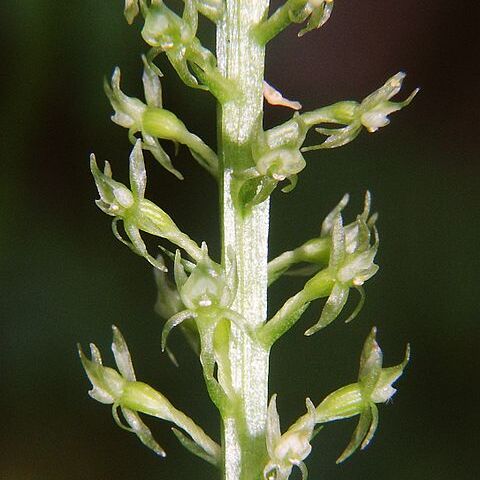Small, erect or repent, terrestrial or epiphytic herbs with cormous pseudobulbs or repent stems. Section EUMALAXIS with cormous, usually hypogaeous, pseudo-bulbs bearing 1 or 2 leaves. Section BLEPHARIGLOTTIS with more or less elongated stems and leaves scattered along them. Leaves 1-3, continued at the base into a sheathing petiole, membranaceous, the lamina usually broad. Scape or peduncle slender, usually elongated. I-nflorescence a spicate or subumbellate raceme; flowers small. Sepals free or the laterals connate, subequal, spreading. Petals equal to the sepals or usually shorter, narrow to subfiliform. Lip erect or spreading, sessile, entire or lobed, usually cordate or auriculate, with the auricles embracing the column, usually broader than the sepals, concave at the base (or plane in Malaxis Wendlandii). Column very short, terete, usually at right angles to the axis of the lip; anther erect or suberect, persistent, 2-celled, the cells often nearly separate; pollinia 4, 2 in each cell of the anther, waxy, their long axis parallel to the long axis of the column or nearly so; caudicle none.
Herbs, terrestrial or rarely epiphytic, occasionally holomycotrophic. Roots hairy. Stem cylindric to pseudobulbous, fleshy, often creeping and rooting in basal part. Leaves, if present, thinly textured to fleshy, usually plicate, petiole sheathing at base. Inflorescences erect, racemose, unbranched; floral bracts persistent, lanceolate or setose. Flowers not resupinate or resupinate, green, brown, yellow, pink, or purple. Dorsal sepal spreading, free; lateral sepals free or fused, spreading. Petals often narrower than sepals, free, spreading; lip erect, flat but sometimes concave at base, entire to lobed, auriculate at base or lacking auricles, apical margin entire or toothed, lacking a spur, callus absent or present and cushionlike or obscurely transversely ridged. Column lacking a foot; anther cap dorsal, attached by a slender filament, locules opening ventrally; pollinia 4, waxy, lacking appendages or rarely with 1 or 2 tiny viscidia; stigma semicircular or ovate; rostellum often obtuse or emarginate at apex.
Small terrestrial lithophytic or epiphytic herbs arising from a creeping rhizome. Secondary stems erect, leafy, ± swollen at base, clustered or not, 1–several-leaved. Leaves thin-textured, plicate, mostly ovate or broadly ovate, with sheathing ± elongate leaf-bases. Inflorescence terminal, erect, mostly densely many-flowered, racemose to subumbellate. Flowers mostly small, non-resupinate, green, buff, orange, or purple. Sepals and petals subsimilar or petals filiform, spreading. Lip larger than other floral segments, flat, entire or lobed, ± auriculate at base on either side of column, margins ± toothed. Column short, porrect, ± auriculate; stigma ventral; anther terminal, flap-like; pollinia ovoid, 4 in 2 pairs joined at base.
Sep and pet unlike, the lateral sep ± parallel behind the lip, the pet much smaller, spreading or recurved; lip relatively broad, variously shaped, often auriculate at base; column very short, in our spp. ca 1 mm or less; pollinia 4; small orchids from a corm, with 1–5 lvs at the base or near the middle of the low scape, and a terminal raceme of small fls. 200, irregularly widespread.
Sepals and petals free, similar or dissimilar, lip larger than tepals, entire or lobed, often ± auriculate at the base; often with dentate margins.
Flowers small, resupinate in the Flora Zambesiaca area, green, yellow-green, buff, orange or purple.
Dwarf terrestrial, lithophytic or epiphytic herb with creeping rhizomes or fusiform tuberous roots.
Column short; stigma ventral; anther terminal; pollinia ovoid, 4 in 2 pairs joined at the base.
Inflorescence erect, terminal, racemose or subumbellate, few-to many-flowered.
Stems leafy, ± swollen at the base; leaves thin-textured, plicate.

